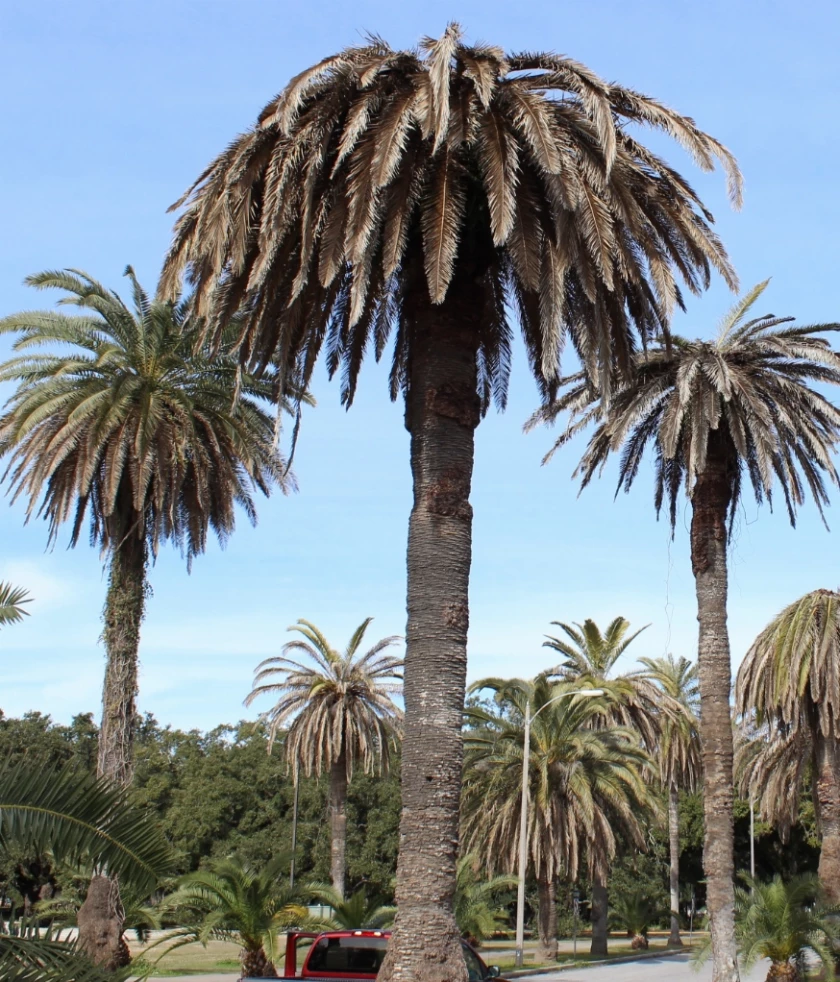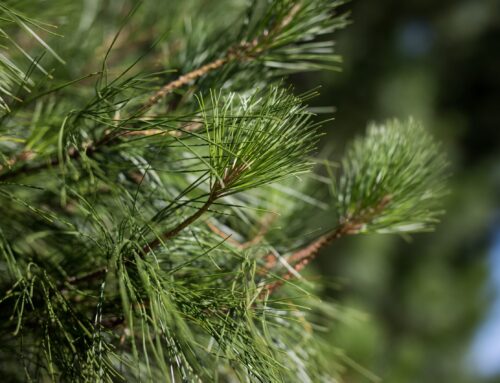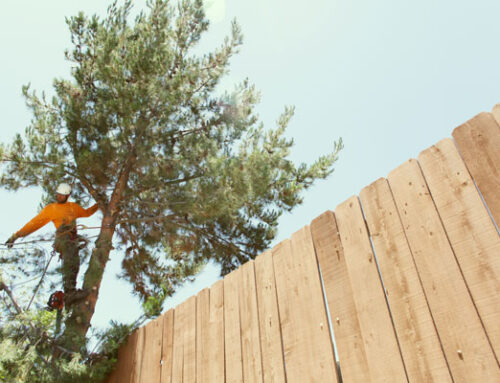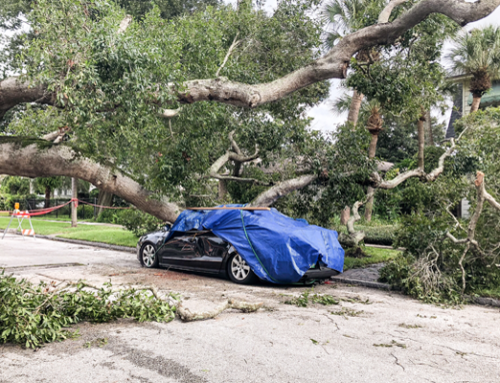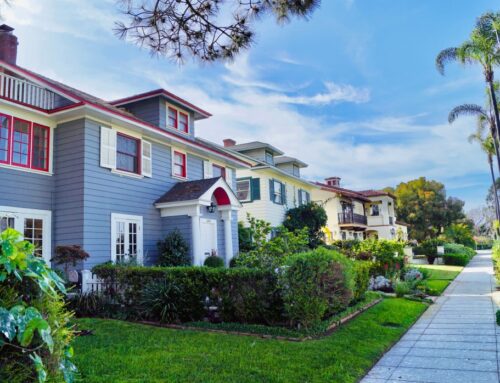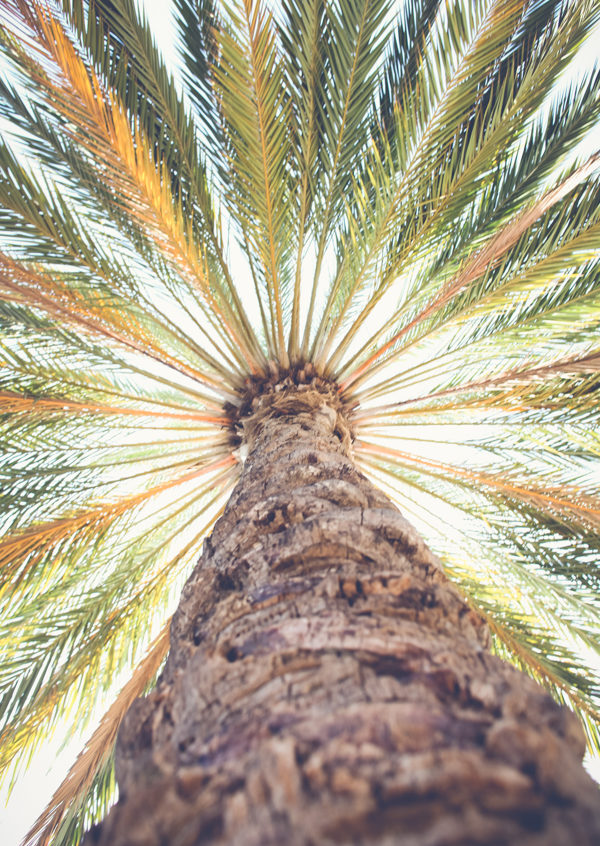
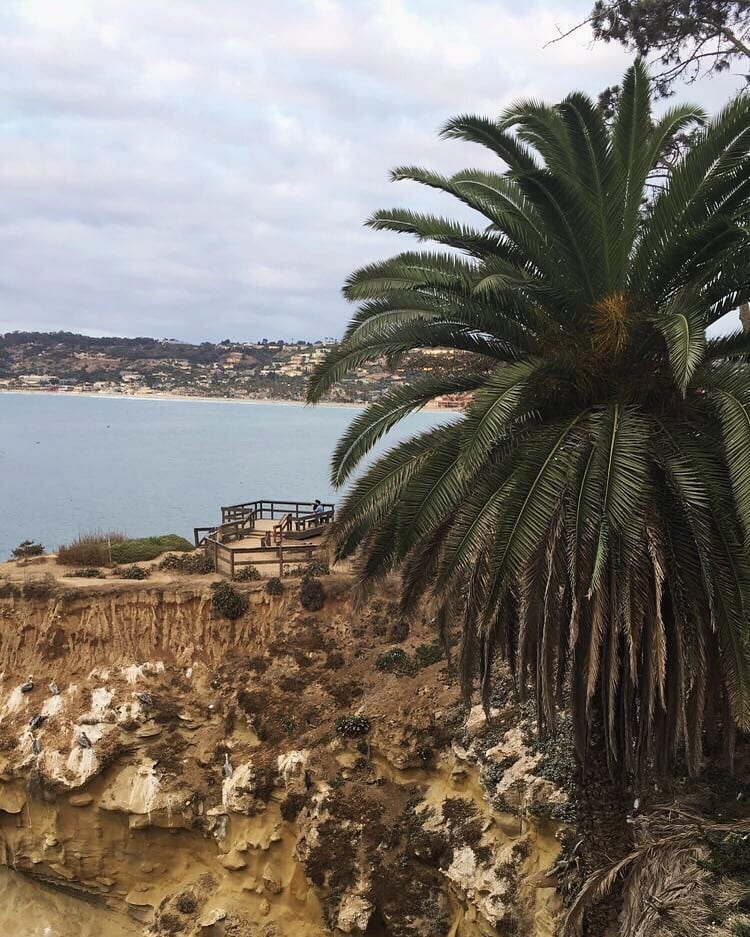
The Canary Island date palm, or Phoenix canariensis, is one of San Diego’s most prominent figures in the “tree” space. When well-manicured, these date palms are majestic and regal with their well-known pineapple crown. They’re a symbol of status and are often a choice ornamental plant that are used in resorts or other high-end properties. A mature Canary Island can even cost upwards of $20,000!
Even though the P. carnariensis is a symbol of status, when unmaintained or growing in the wild, they’re sort of like the troll under the bridge—because frankly, sometimes they do grow under bridges. And when you see them in their disheveled form, they’re huge…and husky…and sort of menacing! Then if you happen to get too close—watch out because they will hurt you! In fact, the spikes on their fronds are sharp enough to penetrate all the way through any of your body parts. Ask any tree trimmer who has worked in these palms, and you’ll quickly learn that the Canary Island date palm is nothing to be messed with.
But unfortunately, something is wiping out Canary Islands all throughout San Diego. You may or may not have noticed that they’re actually disappearing at an alarming rate around our city. You can simply drive down to the coast and you’ll easily spot a dying date palm. These palms aren’t to be mistaken for the popular Mexican fan palm that are everywhere and practically the Southern California symbol. While Mexican fan palms are tall and lanky, their cousin, the Canary Island date palm, is a stocky giant!
What is killing this palm giant?
In fairly recent years, a new visitor to San Diego was first detected. It’s name? The South American palm weevil!
The South American palm weevil—also known as Rhynchophorus palmarum—is native to Central and South America. According to the USDA, the South American palm weevil was first detected in San Ysidro in May of 2011, so it is likely that it flew over from Tijuana, where it had already been causing damage. And since arriving in San Diego, they have been wrecking havoc on our Canary Island population.
Meet what is killing San Diego’s Canary Island Date Palms
What does the South American Palm Weevil look like?
The South American palm weevil is one of San Diego’s list of top wood-boring insects that have been plaguing our city’s trees. It’s a fairly large insect, with adults measuring 1.5-2 inches in length. The adults are solid black and possess an elongated snout called a rostrum, which they use for chewing leaves and boring into their host trees.
If you’re a person who squeals at the sight of maggots and worms, then these weevil babies are one to be avoided. Starting off tiny and white, they quickly fatten themselves up into a plump, yellowish grub with a reddish-brown head—and these babies were made to eat, eat, eat.
How does it kill a Canary Island date palm?
Remember how we mentioned that South American palm weevil larvae are made to eat? Well, it’s not so much the adult weevils that are the lead assassins—but it’s their ravenous babies!
When a female weevil finds a Canary Island date palm that she likes, she burrows deep into the crown to lay her eggs. Once hatched, the young weevils initiate the death sentence of their host as they eat their way through the crown (the “ball” where that the fronds protrude out of). This is where the apical meristem, or heart of the palm is located. Just like a parasitic worm is lethal to any animal when it reaches the heart, the weevil larvae cause the same type of damage. If the heart of the palm, which is responsible for the health of the tree, is compromised with these feeding tunnels, then unfortunately, there is no chance of survival.
It does not take much for a Canary Island to succumb to its unwelcomed guests. Even a small population of 30 little larvae are capable of killing a giant palm!
Does the South American palm weevil only attack the Canary Island date palm?
While this weevil is one picky eater, it does have an appetite for other palms and trees, as well. In fact, it’s been found on more than 30 different plant species. Its primary host plants include the coconut palm African oil palm, sago palm, sugarcane, date palm, and of course—the Canary Island date palm. And it also has an appetite (although not its top choice) for fruit such as pineapple, avocado, and banana. Fortunately, for many host plant species, the damage is insignificant, as the weevil consumes the plant’s fruit, not its heart—as in the case of the Canary Islands.
Even though the weevil enjoys the taste of other hosts, those plants aren’t as prevalent in San Diego. Not to mention, the Canary Island date palm basically screams for attention with its girth and elevated height. Unlike the shorter sago palm, it isn’t very difficult for a flying weevil to catch sight of a Canary Island in our city.
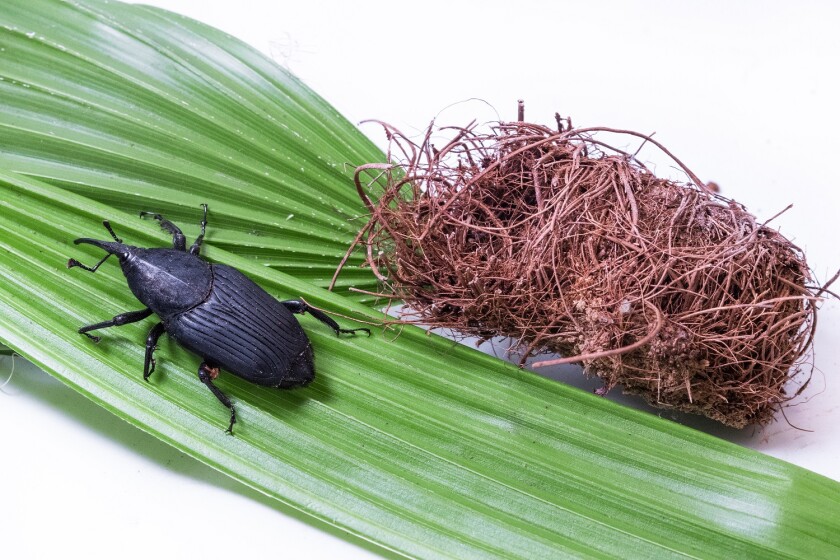
An adult South American palm weevil next to a cocoon that it emerged out of. (Courtesy Mike Lewis, Center for Invasive Species Research, UC Riverside)
What are some signs of a weevil infestation?
Once the heart of the palm is compromised, it’s only a matter of time before the host completely dies. While the chances of survival are slim, the only way to save a Canary Island from this lethal parasite is prevention or early treatment. If you own a Canary Island, then our recommendation is to treat it before a weevil decides to turn it into a nursery.
The date palm’s crown is typically to high to inspect closely—but there are still some early warnings that are visible from the ground. Initial signs can be cut-off leaf tips at the center or top of the canopy. This, however, can also be indicative of rodents, nutrition deficiency, or disease. With a pair of binoculars, you can also look for holes at the base of the fronds.
Typically, a healthy Canary Island has perky green fronds that make up the top section of the canopy and older brown frond in the bottom half. When a palm is suffering from an infestation, then dried-up brown fronds will be noticeable throughout the entire canopy—even starting at the top center. In an advanced stage of infestation, the canopy will appear flat as more fronds begin to droop and die. Eventually, the canopy will end up resembling a giant brown mushroom, as seen in the picture below.
How quickly can the South American palm weevil spread?
Unfortunately, this invasive weevil is an exceptional long-distance flier. According to research performed by UC Riverside, the female South American palm weevil is capable of flying over 100 km in just one day! For a little insect that loses about 18% of its body weight on the journey—it’s an amazing feat that many other flying insects wouldn’t survive.
With its widespread capabilities, thankfully, it has yet to be detected in LA County or nearby Coachella Valley, which together flaunt millions of dollars worth of Canary Islands date palms. But scientists are predicting that it won’t be too long before these neighbors of ours become infested. It’s believed that they haven’t ventured to those regions because they have been quite content making their way through San Diego’s ample supply of Canary Islands.
A look at San Diego’s dying Canary Island date palms
Photo courtesy of Point Loma Association.
These Canary Island date palms in Point Loma are just a few of the many victims of the South American palm weevil. Unfortunately, these infested palms have zero chance of survival. Notice their drooping canopy that resembles the shape of a mushroom.
How else can the South American palm weevil cause damage?
These invasive guests come with a double whammy! Not only are they the most deadly pests of the Canary Island, but they can also be carriers of…oh, just about the most lethal disease for this poor palm—Fusarium wilt. This disease is caused by the fungus Fusarium oxysporum f. sp. canariensis, which was first discovered in California in the 1970’s.
While the South American palm weevil is fairly new to San Diego, Fusarium wilt has been in this region for decades. Fortunately, it can be a slow killer—which is why even though it has been in our city for decades, it hasn’t managed to decimate the date palm population. But UNFORTUNATELY, it kills 100% of its victims! Scientists are working on it, but to-date, there are no treatments against the disease.
As the name implies, symptoms of Fusarium wilt include wilting of the fronds. It’s not just any kind of wilting. The disease causes a unique symptom of “one-sided death” of the fronds’ pinnae, or leaflets. Signs of the disease usually begin with the lower, older fronds, and then moves its way up the rest of the crown.
Fusarium oxysporum f. sp. canariensis is an abnormally resilient fungus that can spread like wild fire. In fact, extra precautions need to be taken when trimming or removing an infected palm. All chainsaws used must be disinfected, as the disease has mainly spread from tree-to-tree through infected saws. Typically, tree trimmers will use a bleach solution, alcohol, or even a blow torch to thoroughly sterilize their saws.
Are there treatments to help save Canary Island date palms?
It’s a sad fate for these beautiful palms that have decorated San Diego landscape for over a century. However, due to the South American palm weevil’s resiliency, insatiable appetite, and rapid spread, scientists predict that the Canary Island date palm will be completely wiped out of this region in less than a decade.
Treatments are available and are being administered throughout the city—however, efficacy rates are too low to have much confidence in their ability to save the city’s palms. While some treatments have been successful at warding off an infestation, often times arborists will end up having to remove a Canary Island that had been aggresively treated regulary for months. Astonishingly, even on such a steadfast pesticide plan, it is not uncommon to still find a whole family of weevils happily going about their business—completely unscathed!
What should you do if you suspect an infestion?
If you notice any browning in the upper half of your Canary Island, then contact LC Tree Service immediately. Appointments with our Certified Arborists are free. If it is determined that the palm is infected with the South American palm weevil, then an immediate removal will be highly recommended to prevent further spread and to prevent sudden tree failure.
A dying or weak palm can create a dangerous environment. Since palms, especially the Canary Island date palm, possess a heavy crown that can weigh well over a ton, any compromise to their structure can cause their crown to suddenly drop if there is enough pressure pulling to any side, such as weight imbalance and/or wind.
Aside from structure failure, if an infected tree is left untouched, then it will only give the larvae time to mature into adults that will inevitably disperse into other host plants. This is why it is so vital if you possess a Canary Island date palm to take immediate action if you suspect an infestation. If we can all help slow down the spread, then we can get to enjoy these majestic palms for more years to come.
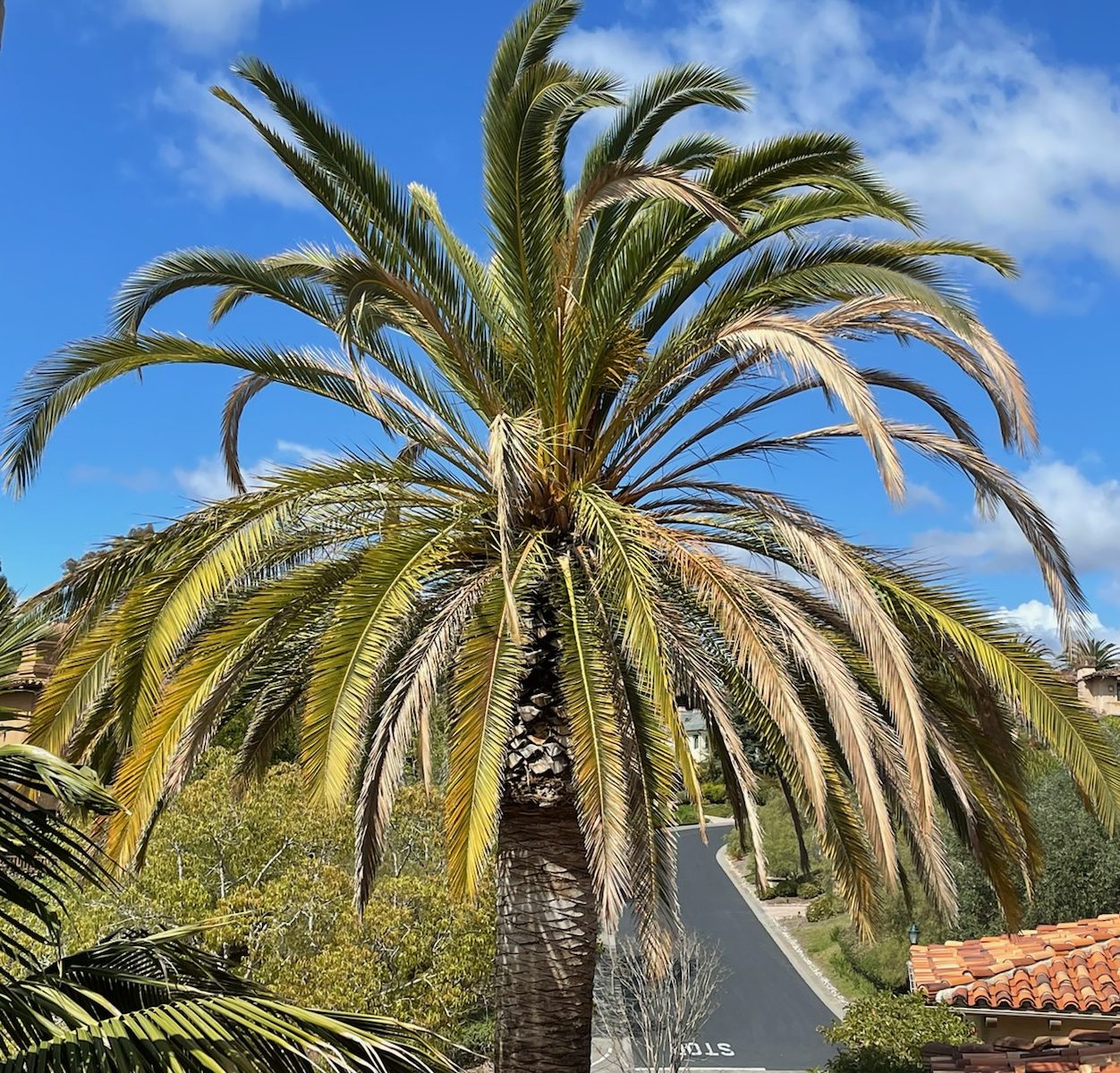
This Canary Island date palm in Rancho Santa Fe is showing signs of stress, which is evident in the premature browning of the fronds. In a healthy palm, dead fronds should only seen in the bottom half of the canopy. But when fronds are brown in the upper half, then it can be a sign of a weevil infestation. However, it can also be evidence of an infection or nutrient deficiency.
If your Canary Island has brown fronds in the upper canopy, then contact LC Tree Service immediately for an assessment.


